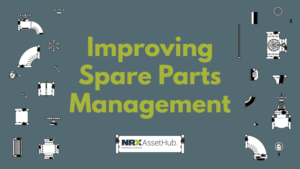Typical tasks of maintenance staff include repairs and routine maintenance. Therefore, they must regularly solve two problems: figuring out required parts and correctly ordering them. This process may seem straightforward, but it can be costly to do correctly.

Why Organizations Care About Spare Parts Management
Spare parts management is a vital component of asset-intensive organizations; poor performance in this area results in unnecessary downtime and delays, expensive procurements, and more.
For that reason, identifying the gaps in the spare parts management process becomes a key concern for most organizations.
Potential Challenges of Spare Parts Management
The first step when given a work order is to search for the vendor documentation of the part. Some companies may keep records in paper format or on a server, but you will typically see it stored in a disconnected Document Management System; this poses some concerns because it becomes difficult to verify if the data is up to date — a time-consuming task maintenance staff will have to do.
To mitigate this issue, planners make spreadsheets with lists of parts needed to maintain various equipment pieces. Even so, this data may not be updated in the EAM/CMMS for staff to use.
Alternatively, you may only be able to find the vendor documents easily if you have the correct equipment model number entered in the EAM system. Strategies to prevent this issue from occuring include:
• Entering the information into the EAM initially.
• Keeping it up to date as replacements occur.
• Ensuring the EAM asset hierarchy includes the equipment by going down to the lowest maintainable level.
Say the staff member successfully finds the vendor information. Now, they must order the equipment pieces. Often, another team is responsible for doing so.
The procurement group must either find the parts in their inventory or order them, but inefficient spare parts management can pose a few obstacles. For example, it may be difficult to find the correct parts in the procurement system, or more information needs to be given to verify whether parts in inventory match those requested by the maintenance team. Moreover, information on where and how to get parts may be unavailable on the system. Additionally, it becomes troublesome to identify correct parts in the system if the information is inconsistently named, duplicated, or obsolete.
Ways to Find and Order Spare Parts Easier
Here are some general tips on fixing issues in a spare parts management process:
– See if there are underlying business issues. Know the company’s goals; find if the EAM and procurement systems are helping you reach them.
– Examine the impact spare parts data have on business problems before making decisions to change current processes.
– Create KPIs on master data completeness, accuracy, and suitability to track progress in reaching desired company goals.
– Implement solutions that standardize data so that best practices are consistent across multiple assets.
– Strategically implement ‘low value’ tasks. For example, BOMs are unnecessary for every equipment piece, so decide which equipment needs them and which does not.
Although these may be good starting points for some, problems can be unique, and evaluating them on a case-by-case basis is beneficial. If you would like some guidance, we can help you. HubHead offers a benchmarking service; we help businesses bridge gaps between their current EAM/CMMS and industry best practices.
Fixing spare parts data can be expensive, but we can provide a plan that maximizes your ROI. One of our consultants would be glad to assist you! Download our brochure or book a meeting.

The Benefits of Spare Parts Management
Tips for Effective Spare Parts Management
Improving spare parts management
Share this article




